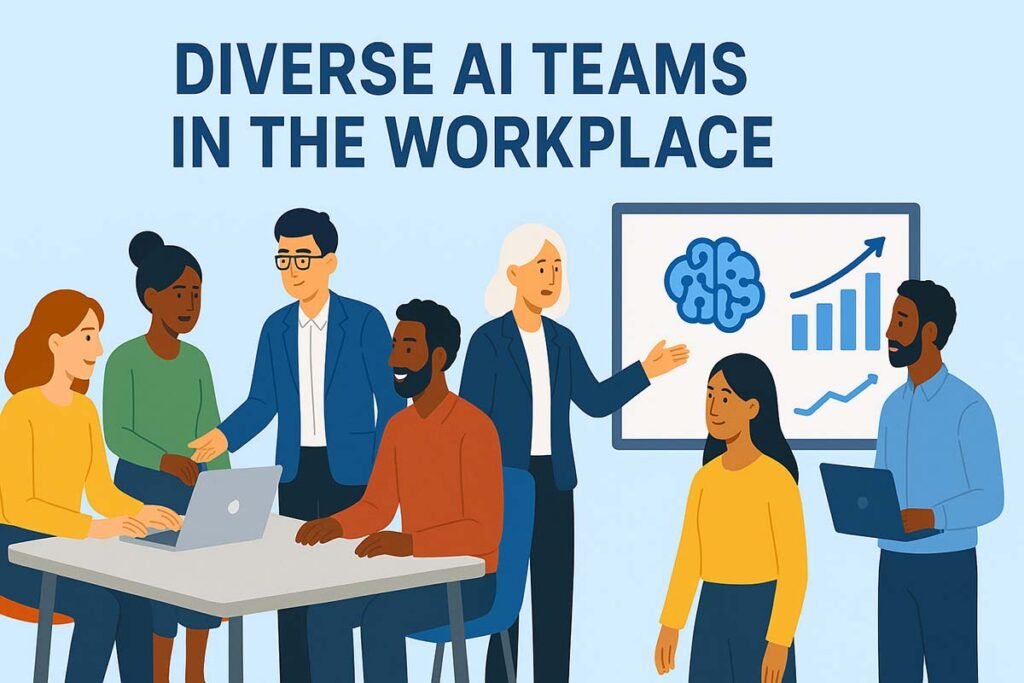Bridging the AI Talent Gap: Artificial Intelligence is revolutionizing every corner of the business world, from healthcare and finance to retail and manufacturing. In the United States, the demand for AI professionals has skyrocketed as organizations compete to innovate and automate. However, an intensifying AI skills gap threatens growth, leaving many companies struggling to attract, develop, and retain top talent.
If left unchecked, this gap could hinder America’s technological leadership and slow down the adoption of transformative solutions. How can companies bridge this divide — and what proven strategies will help them attract and retain the brightest minds in AI? Let’s uncover actionable insights, real-world examples, and practical frameworks for building a future-ready AI workforce that sets your company apart.
Understanding the AI Talent Gap: The State of AI Skills in the US (2025)
The AI talent gap in the US is increasingly evident. Over 83% of workplaces use AI tools for productivity and automation, but only about half of the workforce is trained to utilize these technologies effectively, leading to a sizable skills divide. The gap disproportionately affects older workers, women, and those in non-technical roles, with significant consequences: decreased productivity, increased stress, and even job dissatisfaction. Most IT leaders report an undersupply of AI talent, a jump from 28% to more than 50% within a year. Entry-level hiring in AI is collapsing, while elite labs achieve retention rates near 80–90%—leaving many organizations behind as competition for experienced professionals intensifies.
What’s Driving the AI Talent Gap?
- Rapid pace of AI adoption outstripping workforce training
- Mismatch between AI job demands and available skills
- Geographic concentration of AI jobs in major tech hubs
- Lack of inclusive and accessible upskilling programs
Strategies to Attract Top AI Professionals
Offer Competitive Salaries and Benefits
AI specialists are among the highest-paid professionals in tech. To attract them, companies must move beyond basic compensation to include:
- Generous stock options or RSUs
- Health and mental wellness support
- Remote work flexibility and hybrid arrangements
- Learning and conference stipends
Example: Top labs such as Anthropic and OpenAI have dominated retention by offering high base pay, generous bonuses, and purposeful work with significant global impact.
Create a Positive, Inclusive Work Environment
AI talent seeks organizations fostering respect, creativity, and collaboration. Strategies include:
- Clear mission and commitment to ethical AI
- Emphasis on diversity, equity, and inclusion
- Support structures for mental health
Case Study: Kuehne+Nagel used an AI-powered internal mobility platform to make their workplace more dynamic, improving satisfaction to 74% and increasing retention.

Build a Strong Employer Brand
Establish your company as an AI innovator by:
- Showcasing achievements via thought leadership and case studies
- Publicizing employee stories and culture highlights
- Promoting AI research, open-source contributions, and tech events
Tip: Partner with media outlets, host webinars, and sponsor hackathons to amplify your reputation and attract top candidates.
Tap Untapped Talent Pools
Expanding beyond traditional tech hubs uncovers new sources of AI talent:
- Recruit from secondary U.S. cities and globally via remote roles
- Partner with universities/institutes for research internships and mentorships
- Work with staffing agencies specializing in AI
Expert Opinion: BCG found that companies using a targeted location strategy saw a 7–10% reduction in labor costs, plus better retention thanks to unique local value propositions.
Streamline the Hiring Process
- Fast feedback and organized interviews
- Transparent communication about expectations
- Candidate-centric processes – reduce delays, automate administrative tasks
- Use AI-enabled recruiting platforms to pre-screen and match candidates faster
Strategies to Retain AI Professionals
Provide Continuous Learning and Growth Opportunities
AI professionals value staying ahead. Retain top talent by:
- Funding ongoing certifications and courses
- Sponsoring attendance at major AI conferences (NeurIPS, CVPR, etc.)
- Encouraging publication, patents, and speaking opportunities
- Building internal hackathons and lab rotations
Personalized Career Development and Internal Mobility
Use AI-powered platforms to:
- Map personalized learning journeys for employees
- Suggest internal promotions or lateral moves aligned with interest and skills
- Enable access to mentoring from experts and cross-team collaboration
Case Study: Amazon’s AI-driven onboarding reduced time-to-productivity by 30%, boosted satisfaction by 25%, and increased retention among new hires by 20%.
Foster a Culture of Innovation and Purpose
- Empower employees to work on cutting-edge projects
- Encourage open source innovation and knowledge sharing
- Connect employees with the company’s mission and societal impact
Comparison Table: Attracting vs. Retaining AI Professionals
| Attract | Retain |
|---|---|
| Competitive pay/benefits | Continuous learning |
| Strong employer brand | Internal mobility |
| Inclusive culture | Project ownership |
| Fast hiring process | Mission-driven work |
| AI-powered recruitment | Personalized growth paths |
Use Data & Feedback to Drive Engagement
Regular pulse surveys, transparent leadership communication, and metrics dashboards help identify attrition risks and enable targeted retention interventions.
Address Perceived and Real Challenges
Include pathways for entry-level professionals, retrain non-technical staff, and tackle generational/cultural gaps via tailored upskilling and mentorship.
Real-Life Examples & Case Studies
- Amazon: AI-enabled onboarding led to a 15% drop in turnover and a 25% boost in satisfaction in the first year.
- Kuehne+Nagel: Talent marketplace increased internal hires by 22% and filled roles 20% faster.
- DHL Express: Uses AI for personalized employee career development, aligning growth with business needs.
Expert Quotes:
“AI-driven learning platforms are not just a benefit—they’re a necessity to keep professionals engaged and future-ready.”—AI Skills Frontier Report, Multiverse

Closing the Talent Gap: A Practical Roadmap
1. Assess Your Company’s AI Talent Needs
Map current and future AI skill requirements and prepare targeted hiring/learning interventions.
2. Build Partnerships for Talent Pipelines
Collaborate with top universities (MIT, Stanford, Georgia Tech) and leading online learning providers.
3. Invest in Flexible, Hybrid Work Models
Remote and hybrid AI roles expand access, especially for underrepresented groups.
4. Measure & Improve Continuously
Track retention, productivity, diversity, and engagement; refine strategies as markets and technologies evolve.
The AI talent divide can be bridged with purpose, innovation, and a strategic approach. U.S. companies that invest in competitive compensation, inclusive culture, learning, and personalized growth not only win the best minds—they set themselves up for lasting leadership in artificial intelligence. Don’t settle for chasing talent; become the place where top AI professionals choose to thrive.
Are you ready to build your AI dream team and future-proof your business? Start with these strategies, attract brilliance, and unlock innovation at scale.
FAQs
Q1: Why is the AI talent gap a major challenge for US companies?
A1: Rapid AI adoption has outpaced workforce training. Only 50% of US employees are AI-literate, intensifying competition for specialists.
Q2: What attracts AI professionals most?
A2: Competitive pay, innovative projects, flexible work, and career growth are critical factors for recruiting top AI talent.
Q3: How can companies retain AI professionals?
A3: Personalized learning/crucial development, mission-driven work, and internal mobility help professionals feel engaged and stay longer.
Q4: Are inclusive and diverse cultures important in AI hiring?
A4: Yes, diversity and inclusion are essential for innovation and a positive workplace that attracts and retains top AI professionals.
Q5: What role do universities play in bridging the AI talent gap?
A5: Partnerships with universities enable access to emerging talent, collaborative research, internships, and robust AI pipelines.
Q6: How quickly can effective onboarding impact retention?
A6: AI-powered onboarding can improve retention by 15–20% and satisfaction by 25% within one year (Amazon, 2025).




Pingback: 50 Essential Windows System Administrator Interview Questions and Answers - FirstsPost
Pingback: DeepSeek vs OpenAI: How China's $5.6 Million AI Model is Disrupting Silicon Valley's $100 Million Giants - FirstsPost